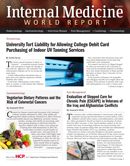Publication
Article
Internal Medicine World Report
Researchers Explore Cardiovascular Disease Relationship In Obese Teens
Author(s):
Among severely obese adolescents, research published in JAMA Internal Medicine found those who underwent weight-loss surgery had several traits making them susceptible for cardiovascular disease (CVD).

Among severely obese adolescents, research published in JAMA Internal Medicine found those who underwent weight-loss surgery had several traits making them susceptible for cardiovascular disease (CVD).
According to the study’s authors, while childhood obesity is rampant, there is limited information available gauging a link between specific CVD risk factors and obesity, and whether this risk would increase throughout elevating body mass indexes (BMIs).
Analyzing data from 5 US adolescent weight-loss surgery centers, investigators followed-up with 242 patients aged 19 or younger who underwent the procedure. The team documented that the participants’ average age was 17 (1.6) years, had a BMI of 50.5, and were not Hispanic (93%).
Through their analysis, they found this group had an increased likelihood of having conditions that put them at risk for CVD, including fasting hyperinsulinemia (74%), elevated high-sensitivity C-reactive protein levels (75%), dyslipidemia (50%), elevated blood pressure (49%), impaired fasting glucose (IFG) levels (26%), and diabetes mellitus (14%).
However, the researchers pointed out that other factors influenced CVD determinant likelihood. For example, boys were more likely to be affected by dyslipidemia (adjusted relative risk = 1.60 [95% CI, 1.26-2.03]; P < .01) and elevated blood pressure (adjusted relative risk = 1.48 [95% CI, 1.16-1.89]; P < .01), and while whites were more impacted by elevated triglyceride levels (adjusted relative risk = 1.76 [95% CI, 1.14-2.72]; P = .01) they did not unequally encounter IFG levels (adjusted relative risk = 0.58 [95% CI, 0.38-0.89]; P = .01).
By splitting patients into 3 groups based on BMI (group 1 (BMI < 50), group 2 (BMI, ≥50-<60), and group 3 (BMI ≥ 60)), the investigators also found a relationship between CVD and BMI. IFG — a CVD risk factor — increased with rising BMI (18%, 31%, and 38% for groups 1, 2, and 3, respectively;P < .01), and similar pattern for high blood pressure (39%, 57%, and 61% for BMI groups 1, 2, and 3, respectively; P < .01) was noted.
“The risk of impaired fasting glucose levels, elevated blood pressure, and elevated high-sensitivity C-reactive protein levels increased by 15%, 10%, and 6%, respectively, per 5-unit increase in BMI (P < .01),” the authors wrote.
In light of their findings, the investigators urged taking on a proactive approach to preventing CVD in obese, young patients as they showed the problem escalates with weight gain.






